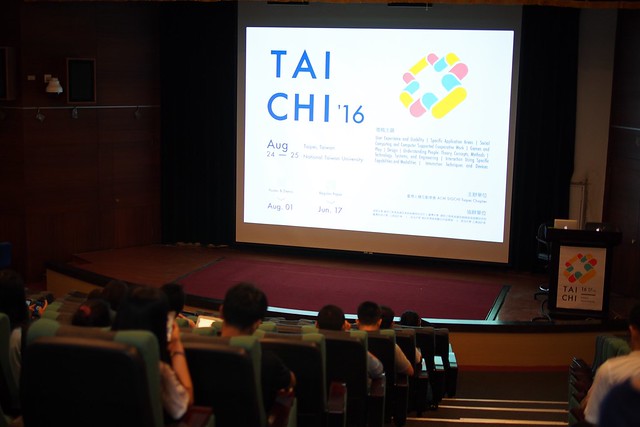About
我們誠摯邀請您投稿及參與 TAICHI 2016 。我們希望人機互動下各個主題的學者與學生都能共襄盛舉。基於人機互動跨領域之特性,本次會議邀集國內外科技 (technology)、設計 (design)、人文與社會科學 (people) 等有關學門之人機互動專家擔任議程委員,在徵稿、審稿、議程安排等各個面向上,都希望能呈現出人機互動繽紛多元的跨領域視野。
ACM SIGCHI 主席 Dr. Loren Terveen 致辭
Greetings to TAICHI 2016 from the SIGCHI Executive Committee!
One of SIGCHI’s current main goals is to promote the development of Human-Computer Interaction in Eastern Asia and -- crucially -- to enable regional HCI communities to become full participants in the global HCI community. To achieve this goal, SIGCHI has sponsored numerous development events; has begun to locate its conferences in the region, including the largest ones, such as CHI, CSCW, UBICOMP, and UIST; and has taken steps to make the CHI conference more accommodating for participants from Eastern Asia. We also have created a committee that focuses on HCI development in Eastern Asia. Given our goals, we are delighted to offer our greetings to the Taiwanese HCI community. We invite and encourage you to discuss opportunities to work with SIGCHI to grow your community and increase your participation in SIGCHI; we look forward to hearing your ideas!
Loren Terveen
President
ACM SIGCHI
來自 SIGCHI 執行委員會的祝賀,祝 TAICHI 2016 會議成功!
促進人機互動在東亞的發展是 SIGCHI 當下一個主要的目標。其中至為關鍵的是提升各地 HCI 社群與 SIGCHI 的連結,使之成為全球 HCI 社群的一份子。為達成這個目標,SIGCHI 贊助了許多的推廣活動,並開始在各地舉辦會議,包括了最為顯著重要的 CHI、 CSCW、Ubicomp 以及 UIST 等會議。我們逐步調整 CHI 會議,希望更能吸納來自東亞的參與者。我們也設置了一個專門委員會聚焦於東亞地區的人機互動發展。在這些大方向的驅策下,我們欣喜地為台灣人機互動社群獻上我們的祝賀。我們邀請並鼓勵您與 SIGCHI 討論各種合作的機會,以發展您的社群並提升在 SIGCHI 的參與。我們期待聽見您的意見與想法!
ACM SIGCHI 主席
Loren Terveen
徵文主題
Regular Paper
Jun. 19
Poster & Demo
Aug. 01
User Experience and Usability
Specific Application Areas
Social Computing and CSCW
Games and Play
Design
Understanding People: Theory, Concepts, Methods
Technology, Systems, and Engineering
Interaction Using Specific Capabilities and Modalities
Interaction Techniques and Devices
投稿方式
論文投稿格式
- 投稿需依循 ACM SIGCHI 之兩欄式的格式撰寫。上傳之檔案須為匿名後之 PDF 檔。一般論文之頁數需大於四頁。亦可使用中文投稿,中文字體建議使用標楷體。
- 標準格式請至 ACM SIGCHI 官方網站下載 (SIGCHI Paper Format 2016)
- 論文頁數以八頁以內為原則。
- 內容中英文皆可,中文格式同上,中文字體請使用標楷體,若為科技部計劃之相關成果,請在論文之誌謝中註明科技部計畫編號。論文 PDF 檔加上附件限制 20 MB 以內
海報投稿格式
- 投稿需依循 ACM SIGCHI Extended Abstract 之格式撰寫。檔案必須為 PDF 檔,不需匿名,總頁數需小於兩頁。海報內容必須包含摘要、研究動機、目的、方法、目前成果、以及未來研究規劃。可使用中文投稿,中文字體建議使用標楷體。
- 論文標題需以「Poster:」或「Demo:」為開頭。
- 標準格式請至 ACM SIGCHI 官方網站下載 (SIGCHI Extended Abstracts Format 2016)
- 所有海報與系統展示將分別列入海報與系統展示獎的審查,得獎者由會議參與者匿名投票選出。
論文徵稿時程
- 一般論文截止:
2016 / 6 / 17 (五)延長至 2016 / 6 / 19 (日) 17 : 00 - 一般論文通知:2016 / 7 / 18 (一)
- 一般論文定稿:2016 / 7 / 25 (一)
- 海報展示截止:2016 / 8 / 01 (一)
- 會議舉辦日期:2016 / 8 / 24 (三)
2016 / 8 / 25 (四)
線上投稿步驟
- 請先至 EasyChair 註冊取得帳號及密碼
- 登入上傳網址
- 進行投稿作業並完成投稿動作,詳細說明請下載 EasyChair 上傳說明
議程內容
Demo / Poster 列表
OpenHCI Demo / Poster
| Demo1 - kemoji |
2106年,人們長期沈溺在虛擬世界中,缺少與彼此面對面的互動。他們所產出的語調缺乏起伏,聲音中沒有表達情緒的線索。交談者們也對語言所傳達的感受, 不為所動。記錄社交中情緒語言及人際流動的 kemoji 於是誕生。「共創、學習、社交」是設計的中心思想,開啟了結合藝術與社交語言學習的創意設計。 kemoji 記錄社交談話場域中,由當次對話所轉換成的圖形和情緒記號,而連繫著發話者的紅線,則象徵情感的連結。kemoji 紀錄的圖像,
是參與者共創的回憶,也是促進對話、復甦參與者聲音情感的良藥。
|
|---|---|
| Demo2 - Moment 摸門 |
家中的房門保護了一個人的隱私,卻也隔絕了兩個空間情緒流動的機會。我們想把這扇房門從界線轉變成媒介, 傳遞門內之人的情緒,也讓門外之人的關心可以被感知。 在未來這個科技冷漠越來越嚴重的世代,親子血緣應是人們永遠不應漠視的一段依附關係, 根據 Wile(1981)的理論,當我們想要表達自己內心的情緒或者擔憂時,有三種方式:攻擊(attack),迴避(avoid)或者吐露(confide)。 但人們往往只會選擇前兩種阻礙情緒流動的方式,而不會選擇第三種促進情緒流動的方式——吐露。我們希望能夠賦予人們將情緒具象化吐露的能力,
連帶提升他人感知情緒的能力,鼓勵親子之間的情緒流動。
|
| Poster1 - Jagger |
我們從「降低音樂參與的門檻」 出發尋找眾多可能性,Jagger 是一系列智慧娛樂配件,創新配件結合肢體律動創造多重聲響,讓你用簡單的肢體動作譜出不凡樂章。
|
| Poster2 - TRANIMAL |
90年後的今天,科技日新月異,各個目的地的旅程縮短了;但是人與人之間的距離卻越來越遠了,因此我們設計了一個大眾運輸的載具是 TRANIMAL,進入TRANIMAL後,擁擠的人潮中,人與人之間為了避免眼神接觸而望向他處。其中的一個人下意識地看向了 TRANIMAL 裡的鏡子,沒想到鏡子中的自己變成了動物....
|
講者介紹
Ed H. Chi 紀懷新 (Google Research and Machine Intelligence)
Optimizing User Experience in the Age of Machine Learning and Data Science (在機器學習和資料科學的時代裡如何提升用戶體驗)
Abstract
At the core of Human-Computer Interaction are theories and methods for optimizing user experience and interactions with computing systems. In this talk, I will illustrate how HCI research could utilize machine learning and data science approaches to optimize
for user experience. The motivation for this new direction is two-fold.
- First, HCI theories have largely been driving by both applied psychology approaches, including both cognitive and behavioral as well as social psychology. Existing actual practice have largely been driving by a set of practical
methods including both qualitative as well as quantitative approaches, such as ethnographic methods, surveys, as well as human performance metrics of attention and cognition. As a new direction, Data Science offer much-needed
new methods for understanding user engagement and behavioral traces both at the macro as well as micro personalized levels.
- Second, machine learning offer many new opportunities and techniques for optimizing toward particular user and system goals. For example, once we understand and define what are happy and engaged users (including using Data
Science methods), we can use ML to optimize for creating more happy and engaged users.
In short, ML+Data+HCI is a winning formula for building user-facing systems, and in this talk, I will illustrate these ideas with a set of short stories and case studies from Google and my past research experiences.
Bio
Ed H. Chi (紀懷新) is a Senior Staff Research Scientist at Google, leading a team focused on recommender and machine learning, as well as social interaction research. Recognized as ACM Distinguished Scientist, he has led research and launched significant product features for Google Play Store and Google+. Prior to Google, he served as Area Manager and Principal Scientist at Xerox Palo Alto Research Center, where he led research on how social computing systems help groups of people to remember, think and reason. With over 35 patents and over 100 research articles, he is known for studying and modeling users' social behaviors and interactions, such as the underlying mechanisms for conflicts and contributions in Wikipedia. He is a recognized expert in intelligent user interfaces, recommenders, crowdsourcing, Web analytics, data science, and information visualization, and serves on the editorial board of ACM TOCHI and TIIS. He has been featured and quoted in the press, including the Economist, Time Magazine, LA Times, and the Associated Press. In his spare time, Ed is an avid photographer and snowboarder. Ed completed his three degrees (B.S., M.S., and Ph.D.) in 6.5 years from University of Minnesota.
Henry Duh 杜本麟 (University of Tasmania)
Interaction Design Issues of Augmented Reality System (擴增實境系統的互動設計議題)
論壇講題:Research Impacts: Implications of Global Education Competitions and Collaboration
Bio
Prof. Duh is the Head of Discipline of ICT, Director of Human Interface Technology Laboratory Australia (a joint research centre between University of Washington and University of Tasmania) and a joint faculty member in the School of Engineering and ICT. He received his degrees in psychology, industrial design and engineering respectively. After finishing his PhD, he went to NASA-Johnson Space Centre as a postdoctoral fellow involving in a virtual reality project. Prof. Duh is a ACM Distinguished Speaker, Fellow of the Institution of Engineering and Technology (FIET), Fellow of the British Computer Society (FBCS), a Senior Member of both ACM and IEEE (SMACM, SMIEEE); the Australian national representative of the International Federation of Information Processing Technical Committee on Human-Computer Interaction (IFIP TC13) and Entertainment Computing (TC14); Steering committee member of IEEE ISMAR, Asia Pacific CHI and ChineseCHI conference. He has been named as one of the Asian Human-Computer Interaction Heroes in ACM CHI2015. He is the Editor-in-Chief of Journal of Visual Languages and Computing (Elsevier) and Gaming Media and Social Effects Book Series (Springer), the Associate Editor of ACM Entertainment in Computer, editorial board member of HCI book series(Springer), and published more than 100 conference and journal papers in HCI area. Prof. Duh was the co-director of Keio-NUS CUTE centre (a joint research centre between NUS and Keio University, Japan) and successfully attracted more US$5M funding as the Lead CI/PI (or US$10M as CI/Co-PI) from government agencies and industries. He actively engages with local communities. He is a Board Director of Tourism Northern Tasmania, a steering committee member of Launceston Digital Media Hub project (AUD$3M Federal government initiative), a member of Australian Council of Deans of Information and Communication Technology, a board member of Engineering Australia Northern Tasmania, Australia Computer Society (Tasmania Branch), NICTA University Planning Committee and participate in federal and state funded projects such as SenseT program and Australia Research Council ITRH Pathway to Market project and Transforming Mining Value Chain Project (AUD$6.4M in Total). His current research focuses on user experience and interaction design, augmented/virtual reality and gaming effects in mobile systems. Prof. Duh is a private pilot (PPL) and certified advanced ground instructor (AGI) by the FAA.
Lin-Lin Chen 陳玲鈴
(National Taiwan University of Science and Technology & Eindhoven University of Technology)
Bio
Lin-Lin Chen is professor in the department of industrial and commercial design at National Taiwan University of Science and Technology (Taiwan Tech) and chair of design innovation strategy at the faculty of industrial design at Eindhoven University of Technology (TU/e) in the Netherlands. She received B.S. degree from National Cheng Kung University in Taiwan, and Ph.D. from the University of Michigan at Ann Arbor. She was dean of the college of design at Taiwan Tech from 2004 to 2010, president of the Chinese Institute of Design from 2007 to 2008, and convener for the arts (and design) area committee of Taiwan’s National Science Council from 2009 to 2011. She is the editor-in-chief of the International Journal of Design (SCI, SSCI, AHCI), vice president of the International Association of Societies of Design Research (IASDR), and fellow of the Design Research Society. Her research focuses on product aesthetics, design innovation, and interaction design for internet of things.
Tsai-Yen Li 李蔡彥
(Ministry of Education & National Chengchi University)
論壇講題:從人機互動看跨領域資訊教育的重要
Bio
Tsai-Yen Li received his BS in 1986 from National Taiwan University, Taiwan, and MS and Ph.D in 1992 and 1995, respectively, from the Computer Science and Mechanical Engineering Departments of Stanford University. He is a Distinguished Professor in the Computer Science Department and the Program of Digital Contents and Technologies in National Chengchi University. Since 2014, he has been serving as the director of the Department of Information and Technology Education in the Ministry of Education in Taiwan. At NCCU, he served as the departmental chair, director of Computer Center, director of Teach and Learning Development Center, and the Secretary General of the university. His main research interests include Computer Animation, Motion Planning, Virtual Environment, Intelligent User Interface, Robotics, Interactive Storytelling, and Artificial Life. He is a member of IEEE, ACM, IICM, and TAAI in Taiwan.
David Chen 陳文剛
(Taiwan User Experience Professional Association)
論壇講題:Reshaping business with user experience design (用戶體驗設計如何改變商業)
Bio
David Chen (陳文剛) is co-founder & supervisor of Taiwan User Experience Professional Association (UiGathering), and UX Director of AJA Creative. With more than 17 years experience in UX design & consulting, he is insightful & practical in designing holistic experience across various domains, including finance, telecom, transportation, medical, retail, travel, education, networking, etc. Now he is more focusing on UX team facilitation, Agile UX, and design innovation.
議程委員
大會主席
洪一平(臺灣大學)陳玲鈴(臺灣科技大學)
陳炳宇(臺灣大學)
議程共同主席
王浩全(清華大學)余能豪(政治大學)
朱宏國(清華大學)
許有真(清華大學)
梁容輝(臺灣科技大學)
曾元琦(成功大學)
議程委員
王昱舜(交通大學)
王照明(雲林科技大學)
王聖銘(臺北科技大學)
江振維(臺北商業大學)
李峻德(交通大學)
林士勛(海洋大學)
林文杰(交通大學)
林日璇(政治大學)
林怡伶(中山大學)
林維真(臺灣大學)
侯君昊(交通大學)
姚智原(臺灣科技大學)
洪偉肯(聯合大學)
紀佩妤(加州大學柏克萊分校)
唐玄輝(臺灣科技大學)
孫 民(清華大學)
袁千雯(賓州州立大學)
張永儒(密西根大學)
張登文(雲林科技大學)
梁容豪(臺灣大學)
莊佳蓉(成功大學)
莊雅量(NTU IoX 研究中心)
許峻誠(交通大學)
陳攸華(中央大學)
陳俊智(高雄師範大學)
陳冠文(交通大學)
陳奕麟(加州大學戴維斯分校)
陳彥仰(臺灣大學)
陳相廷(雪梨科技大學)
陶振超(交通大學)
胡敏君(成功大學)
游創文(臺灣大學)
游曉貞(臺中科技大學)
黃仲菁(臺灣大學)
黃俊堯(臺北大學)
黃傳哲(密西根大學)
楊政達(成功大學)
葛如鈞(臺北科技大學)
詹力韋(慶應義塾大學)
廖冠智(新竹教育大學)
劉晨鐘(中央大學)
蔡文傑(雪梨科技大學)
鄧怡莘(臺灣大學)
鄭文皇(中央研究院)
盧俊銘(清華大學)
賴祐吉(臺灣科技大學)
蘇志昇(實踐大學)
饒培倫(北京清華大學)
海報論文與系統展示共同主席
張永儒 (密西根大學)黃怡靜 (臺灣大學)
Best of CHI 共同主席
梁容豪 (臺灣大學)Best Paper Award 共同主席
陳炳宇 (臺灣大學)岳修平 (臺灣大學)
梁容輝 (臺灣科技大學)
余能豪 (政治大學)
學生共同主席
楊期蘭 (清華大學)王碩平 (清華大學)
鄭竣丰 (政治大學)
張家盛 (清華大學)
葉育婷 (成功大學)
杜佩芸 (清華大學)
陳美伶 (清華大學)
黃大源 (臺灣大學)
網站製作
王碩平 (清華大學)林冠宇 (清華大學)
視覺設計
許元耀 (臺灣科技大學)出席會議
票價資訊
早鳥票(8/16 前報名享有早鳥票優惠)
- 學生:1,100
- 教職人員:1,500
- 一般人士:2,500
正常票(8/22 18:00 前線上註冊,或於會議期間現場註冊)
- 學生:1,500
- 教職人員:2,500
- 一般人士:3,000
線上報名
按此前往 KKTIX 進行報名與付款交通方式




文湖木柵線 徒步約15分
後,右轉直走道語言訓練中心後左轉楓香道,經過社會系館後便抵達資訊系德田館。

松山新店線 徒步約15分
轉水杉道,看到電機二館後左轉楓香道,經過電機二館後便抵達資訊系德田館。

公車298 徒步約3分
德田館。

公車237、295 徒步約10分
走到語言訓練中心後左轉楓香道,經過社會系館後便抵達資訊系德田館。

晚宴地點



